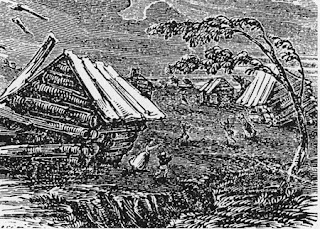Tecumseh, Treaty of Fort Wayne and the Comet of 1811
In September 1809 William Henry
Harrison, then governor of the Indiana Territory, invited the Potawatomi, Lenape, Eel River people, and the Miami to a meeting in Fort Wayne, Indiana.
In the negotiations, Harrison promised large subsidies and payments to the
tribes if they would cede the lands he was asking for.[29] After two weeks of negotiating, the
Potawatomi leaders convinced the Miami to accept the treaty as reciprocity,
because the Potawatomi had earlier accepted treaties less advantageous to them
at the request of the Miami. Finally the tribes signed the Treaty of Fort
Wayne on September 30, 1809, thereby selling the United States over
3,000,000 acres (approximately 12,000 km²), chiefly along the Wabash River north of Vincennes, Indiana.[29]
Tecumseh was outraged by the Treaty
of Fort Wayne, believing that American Indian land was owned in common by all
tribes, an idea advocated in previous years by the Shawnee leader Blue Jacket and the Mohawk leader Joseph Brant.[30] In response, Tecumseh began to expand
on the teachings of his brother, known as The Prophet, who called for the tribes to return
to their ancestral ways. He began to associate the teachings with the idea of a
pan-tribal alliance. Tecumseh traveled widely, urging warriors to abandon the
accommodationist chiefs and to join the resistance at Prophetstown.[30]
In August 1810, Tecumseh led 400
armed warriors to confront Governor Harrison in Vincennes. Tecumseh demanded
that Harrison nullify the Fort Wayne treaty, threatening to kill the chiefs who
had signed it.[31] Harrison refused, stating that the
Miami were the owners of the land and could sell it if they so chose.[32] Tecumseh left peacefully, but warned
Harrison that he would seek an alliance with the British unless the treaty was
nullified.[33]
 |
|
The Great Comet of 1811, as drawn by
William Henry Smyth
|
In March the Great Comet of 1811
appeared. During the next year, tensions between American colonists and Native
Americans rose quickly. Four settlers were murdered on the Missouri River and, in another incident, natives
seized a boatload of supplies from a group of traders. Harrison summoned
Tecumseh to Vincennes to explain the actions of his allies.[33] In August 1811, the two leaders met,
with Tecumseh assuring Harrison that the Shawnee intended to remain at peace
with the United States.
Afterward Tecumseh traveled to the
Southeast on a mission to recruit allies against the United States among the
"Five Civilized Tribes."
His name Tekoomsē meant "Shooting Star" or "Panther
Across The Sky."[34] He told the Choctaw, Chickasaw, Muscogee, and many others that the comet of March
1811 had signaled his coming. He also said that the people would see a sign
proving that the Great Spirit had sent
him.
While Tecumseh was traveling, both
sides readied for the Battle of Tippecanoe.
Harrison assembled a small force of army regulars and militia in preparation to combat the Native
forces.[35] On November 6, 1811, Harrison led this
army of about 1,000 men to Prophetstown, Indiana,
hoping to disperse Tecumseh's confederacy.[36] Early next morning, forces under The
Prophet prematurely attacked Harrison's army at the Tippecanoe River near the
Wabash. Though outnumbered, Harrison repulsed the attack, forcing the Natives
to retreat and abandon Prophetstown. Harrison's men burned the village and
returned home.[37] This was the end of Tecumseh's dream
of a united native alliance against the whites.
On December 11, 1811, the New Madrid
earthquake shook the Muscogee lands and the Midwest.
While the interpretation of this event varied from tribe to tribe, they agreed
that the powerful earthquake had to have meant something. The earthquake and
its aftershocks helped the Tecumseh resistance movement as the Muscogee and
other Native American tribes believed it was a sign that the Shawnee must be supported
and that this was the sign Tecumseh had prophesied.
 |
|
The New Madrid earthquake was interpreted by the Muscogee as
a reason to support the Shawnee resistance.
|
Piqua Shawnee

